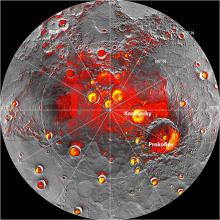Listen to today's episode of StarDate on the web the same day it airs in high-quality streaming audio without any extra ads or announcements. Choose a $8 one-month pass, or listen every day for a year for just $30.
You are here
Venus and Mercury
The Sun’s two closest planets are snuggling close to each other. They’re quite low in the southwest at sunset. But they’re both bright, so if you time it right, you should be able to pick them out.
Venus is lower but brighter — the “evening star.” Fainter Mercury is a little above it. Mercury is the Sun’s closest and smallest planet, with Venus the next one out.
Mercury has no atmosphere to speak of. So with no wind or rain, any changes on its surface have to come from inside the little planet, or from impacts by objects beyond Mercury.
A recent study found that the surface changes much more often than expected. And most of the changes are driven from within.
Scientists compared more than 58,000 pairs of images from the Messenger spacecraft, which orbited Mercury from 2011 to 2015. It snapped pictures of the same regions of the planet at different times. By comparing those images, scientists found 20 changes to the surface.
One of them was an impact crater — a hole gouged by a collision with a space rock. But the others probably were caused by processes inside Mercury itself. They all appeared in regions that are associated with volcanic activity. So the features probably were created by quakes, the motions of molten rock, or other internal activities. The number of new features suggests that Mercury’s surface changes a lot — driven from inside the Sun’s smallest planet.
Script by Damond Benningfield






